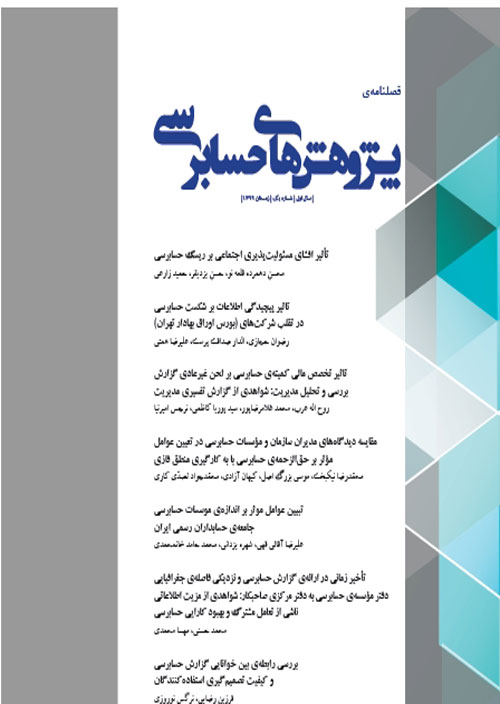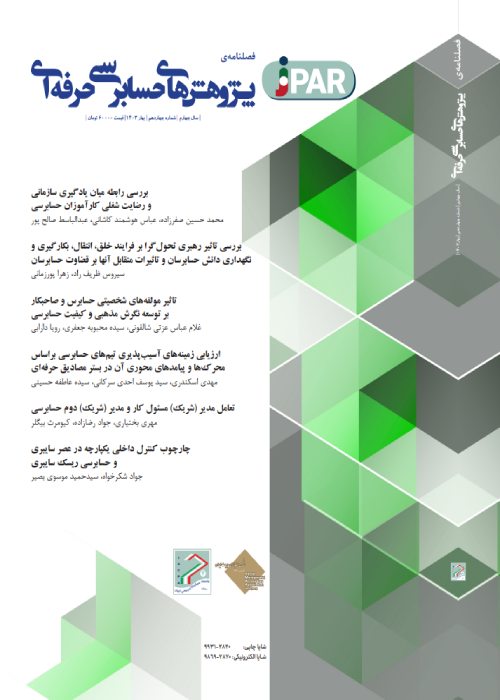فهرست مطالب

نشریه پژوهش های حسابرسی حرفه ای
پیاپی 1 (زمستان 1399)
- تاریخ انتشار: 1400/01/15
- تعداد عناوین: 8
-
-
صفحه 5
-
Page 7
According to the Auditing Standards، the entity may attempt to disclosing financial and non-financial information about its operation، and the auditor is required to evaluate this information. Social responsibility performance is typically included in this regard، and the independent auditor should attention to such specific information in adequately assessing audit risk. The primary purpose of this academic paper is to promptly investigate the possible relationship between social responsibility disclosure and audit risk in the Tehran Stock Exchange. In this regard، the content analysis method is used to measure social responsibility disclosure، and audit risk is calculated by the audit fees. To examine the hypotheses، Based on a sample of 93 firms data are gathered covering the period 2012–2019 applies ordinary least squares regression (OLS). We subsequently observe a direct association between social responsibility disclosure and audit risk. This relationship is confirmed in a sensitivity analysis employing panel methods with random effects as well as generalized least squares. Expanding the disclosure of social responsibility may end in the higher audit risk; hence، audit fees increase. This issue warns users of financial statements، including investors، that attention to not only the positive aspects of social responsibility disclosure in Iran forgetting social responsibility disclosure can be used as a mechanism to conceal poor performance.
Keywords: Audit fees, Audit risk, Social Responsibility Disclosure -
Page 31
One of the important issues in auditing is the failure of auditing in corporate fraud، which according to previous research and the theory of agency representation with related parties and product diversity complicates independent financial audits، increasing the complexity of corporate information، information transparency Reduces and therefore increases the information asymmetry between managers and auditors and increases audit risk. In order to test these hypotheses in the companies listed on the Tehran Stock Exchange، two samples of 97 and 105 companies in the period 1390 to 1397 have been used. The results of estimating logit regression equations do not show any significant relationship between the complexity of information resulting from transactions with related parties، with audit failure. The results of estimating the logit regression equations of the second hypothesis show the existence of significant and positive relationships between the complexity of information resulting from product diversity، with audit failure. In other words، this research shows that when auditors have a variety of products، auditors، They should pay attention to the presentation of professional audit work. Although these results are consistent with the findings of some similar studies in the literature، nevertheless، suggestions have been made for further studies to find variables affecting audit failure in Iran.
Keywords: Audit failure, Corporate fraud, Information complexity, Related-party transactions, Diversification -
Page 53
Since the tone of the managers influences the decision-making of the users of financial reports, the existence of independent and specialized committees in the company such as the audit committee can be effective as one of the pillars of corporate governance to monitor such actions of managers. Therefore, The main purpose of this study is to investigate the effect of the financial expertise of the audit committee on the abnormal tone of the management review and analysis report (management interpretive report) in companies listed on the Tehran Stock Exchange. To test the research hypothesis, the financial information of companies listed on the Tehran Stock Exchange in the period between 1396 to 1397 has been used, so that after applying the restrictions in this study, the final sample consisting of 168 companies was selected. After measuring the research variables, multivariate linear regression analysis was used to test the research hypothesis. The hypothesis was also tested using Eviews econometric software and statistical techniques of integrated data. The results of the statistical tests of the research show that the financial expertise of the audit committee leads to a reduction in the unusual tone of the management interpretative report.
Keywords: Audit Committee Financial Expertise, Abnormal Tone, ManagementManagement Discussion, Analysis Report, Management InterpretationReport -
Page 71
The present research seeks to determine the priorities of the managers of the organization and the audit firms in determining the audit fees and compare these views with regard to the conditions (monopoly or competitive) of each of them in the pricing of audit services. Be Based on the analysis of the content of theoretical literature and audit experts, 17 factors were identified as affecting the determination of audit fees. The statistical sample consists of 15 managers of audit organization and 15 managers of audit firms. The required data were collected by means of a paired comparison questionnaire and the verbal indices were extracted from the questionnaire to determine the factors affecting the audit fees paid from the perspective of the audit firm’s managers and other audit institutions by the Excel software. The basis of the fuzzy logic is made. After the phase-out phase, and the comparison of factors weights from both groups, 9 factors of 17 factors were identified as the most important factors influencing audit fees. Although there was no significant difference between the two groups in determining the most important factors affecting audit fees, the weighting of the nine factors was different from the viewpoint of the two groups in determining audit fees. The 9 factors affecting the determination of audit fees are: the volume of operations, the complexity of the operation, the quality and effectiveness of the internal controls of the entity under investigation, the geographical distribution of the audit operation، the size of the unit reviewed, the initial audit، the employer’s risk, the characteristics of the auditor and Duration of the auditor’s responsibility in a registrar unit.
Keywords: Audit Fees, Audit Organization, Audit Institutions, Fuzzy Logic -
Page 91
The present study seeks to assess the determinants of the size of the audit firms of Iran’s public accountants community. The research period is from 1391 to 1397. The statistical population of this study is data on the 229 institutes of the Association of Iranian Accountants, including the amount of income, the number of CPA employed, the number of audit firms, quality control points by the Iranian association of Certified Public Accountants and the rankings of the securities and stock market organization. The results of the research show that the quality control score, the number of CPA in employment, the rating of institutions and the number of partners in institutions affect the size of enterprises. Also, Granger’s causality test results indicate that the quality control rating of the community of Certified Public Accountants is the reason for the ranking of the audit firms by the Tehran Stock Exchange Organization.
Keywords: Audit quality, Financial reporting quality, Audit size, SECRanking -
Page 117
This paper assessed the relationship between auditor-client geographic proximity and audit report lag. Research data include 917 firm-year observations which consist of 131 sample firms listed in Tehran Securities & Exchange over the period 2013 to 2019. Research hypotheses analyzed using multivariate regression models based on panel data with fixed effect and generalized least squares method. The results documented that auditor-client geographic proximity caused to decrease the audit report lag. Because such auditors are able to interact more frequently with the client and obtain client-specific news, which increases their ability to effectively monitor the client; so it lead to decrease the auditor report lag. According to the findings, some client characteristics, auditor characteristics, board & audit committee characteristics had impact on audit report lag. Modified audit opinion, board financial expertise, bad news,financial distress position, reporting risk & complexity, external financing and product market competition had direct impact on auditor report lag; auditor rotation, auditor quality rank, audit committee independence and firm size had inverse impact on auditor report lag. But audit fee, board independence, institutional ownership, ownership concentration, audit committee financial expertise, financial leverage, capital expenditure and loss had no impact on auditor report lag.
Keywords: Audit Report Lag, Geographic Proximity, Auditor-Client Distance, Audit Efficiency -
Page 145
The auditing report as the outcome of auditing and, in fact, the report that shows the result of the review of the financial statements, should be understandable in the eyes of users and be a source of information. In the other words، the auditing report should be able to influence the users’ decision. Auditing report readability means that it is understandable for users. Improving the auditing report readability is expected to improve the users’ decision making quality. In the other words, it is expected that the auditing report is more readable, investing more easily from investors and obtaining facilities from creditors, and reducing the conflict of interests between managers and owners. The purpose of this study is to investigate the effect of auditing report readability on the users’ decision making quality. In this paper, three of the most important users, including investors, creditors and managers, have been considered. To investigate this issue, data from 61 firms listed in Tehran Stock Exchange during the years 1392 to 1398 has been used. In general, the results indicate that there is a positive relationship between auditing report readability and investors’ decision making quality.
Keywords: Auditing report readability, Users of auditing report, Investors’decision making quality, creditors’ decision making quality, Managers’ decisionmaking quality


